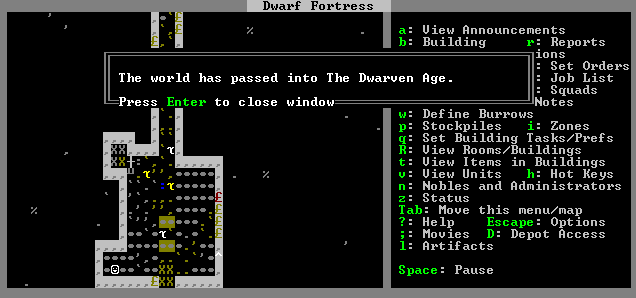- v50 information can now be added to pages in the main namespace. v0.47 information can still be found in the DF2014 namespace. See here for more details on the new versioning policy.
- Use this page to report any issues related to the migration.
Difference between revisions of "v0.31:Calendar"
m |
|||
| Line 89: | Line 89: | ||
All worlds start in the Age of Myth, which describes a time when living gods and mighty beasts still held sway over the world. | All worlds start in the Age of Myth, which describes a time when living gods and mighty beasts still held sway over the world. | ||
| + | [[File:Dwarven_Age.png]] | ||
== Farming == | == Farming == | ||
Revision as of 18:44, 3 December 2010
| This article is about an older version of DF. |
The dwarven calendar is used to display the day, month, and year of any given date, and is visible in the upper right corner of the Template:L Screen (z). There are 12 months in the dwarven year divided into 4 seasons of 3 months each. Unlike the traditional Gregorian calendar, each dwarven month is exactly 4 weeks long, or 28 days. New Year's Day and the first day of Spring both fall on the 1st of Granite. New Year's Eve and the last day of Winter both fall on the 28th of Obsidian. The months are named after kinds of Template:Ls, Template:L, Template:Ls and Template:L.
The game's first playable year begins whenever the world stops generating. By default, the world will stop genning at year 250. Worldgen can be set to stop at several distinct years ranging from 5 to 1050 when selecting Create a World, and can also be set to any arbitrary year by editing the advance option End Year in the Design New World with Advanced Parameters screen.
Months and seasons
| Month | Real life version | Season | ||
|---|---|---|---|---|
•
|
Template:L | March | Early- | Spring |
•
|
Template:L | April | Mid- | |
•
|
Template:L | May | Late- | |
*
|
Template:L | June | Early- | Summer |
*
|
Template:L | July | Mid- | |
*
|
Template:L | August | Late- | |
•
|
Template:L | September | Early- | Autumn |
•
|
Template:L | October | Mid- | |
▬
|
Template:L | November | Late- | |
♦
|
Template:L | December | Early- | Winter |
♦
|
Template:L | January | Mid- | |
•
|
Template:L | February | Late- | |
Ages
In addition to the year, a world's history is also divided into ages. An age can be seen as an epoch, something which defines the period of years it describes. The age itself has no bearing on gameplay other than as categorization in Legends mode, though players may witness a change in age (with an accompanied announcement) should their actions cause the current age to end. This may happen after killing a large amount of megabeasts.
All worlds start in the Age of Myth, which describes a time when living gods and mighty beasts still held sway over the world.
Farming
The seasons correspond to growing seasons from the Template:L q menu, which dictate what can be grown when during the year. (See the Template:L.) It should be noted that crops grow during seasons regardless of the actual weather, so any crops that grow during the spring will do so regardless of how much rain your area gets.
Trading
Civilizations will visit your fortress based on what season it currently is. Trade caravans for each race show up during the specific seasons each year, with the elves arriving during the Spring, the humans during the Summer, and the dwarves during the Fall. No caravans arrive for the winter, so it's smart to stock up on food and drink during the fall
